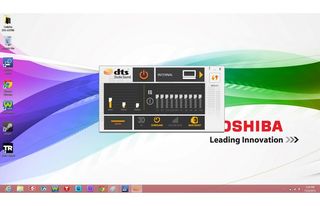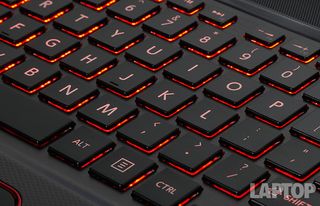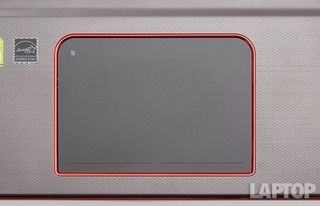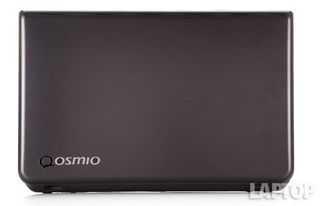Laptop Mag Verdict
The Toshiba Qosmio X75 is a gaming notebook whose raucous power, gorgeous display and sexy design will surely get your blood pumping.
Pros
- +
Gorgeous 1080p display
- +
Powerful performance
- +
Impressive audio
- +
Sexy styling
Cons
- -
Slight gaming frame rate issues
- -
Undersized directional keys
Why you can trust Laptop Mag
Toshiba has unleashed the latest version of its Qosmio-series gaming rig, and this iteration is the best one we've seen yet. Packing a quad-core Intel Core i7 processor, 16GB of RAM and an Nvidia GeForce GTX 770M graphics chip, the relatively affordable Qosmio X75 ($1,769 as configured), can absolutely fly. Still, this rig has some serious competition from ASUS and Alienware. So should you be pwning noobz on this new Qosmio?
[sc:video id="s4OHE1cTrTfVNmCa46t9TlV6ZoBFnSak" width="575" height="398"]
Design

As with the previous generation, Toshiba has cloaked the Qosmio X75 in its Black Widow-style textured aluminum. The texture, which closely resembles a snake's trianglelike scales, coats everything from the laptop's lid to its keyboard deck. Fortunately, Toshiba has done away with the gaudy backlit Qosmio logo emblazoned across the center of the previous generation's lid. In its place, Toshiba chose to go with a more understated chrome Qosmio emblem situated in the lid's lower right corner.

Click to EnlargeAdding to the Qosmio's slick design is a solid strip of red chrome running around the laptop's edges. The same chrome encircles the Qosmio's touchpad. Above the keyboard deck is the Qosmio's frameless keyboard, which is accented by a brushed aluminum backplate and, above that, you'll find a massive speaker grille that runs the length of the laptop. The Qosmio X75's power button lives in the upper right corner of the deck with its attractive red LED backlight.
Measuring 16.5 x 10.7 x 1.2-1.7 inches and weighing a hefty 7.4 pounds, the Qosmio X75 is slimmer than the ASUS G750JX-DB71, which measures 16.1 x 12.5 x 0.66-1.9 inches and weighs 8.8 pounds. The enormous Alienware 17, meanwhile, measures 17.9 x 12.9 x 0.7-1.9 inches and weighs a neck-straining 9.2 pounds.
MORE: Best Laptops
Display

Click to EnlargeThe Toshiba Qosmio sports a gorgeous 1920 x 1080p resolution TruBrite LCD display. Like most Windows 8 gaming notebooks, the Qosmio lacks a touch screen. The lack of touch means you'll have to perform Windows 8 gestures using the laptop's touchpad, which is, thankfully, very responsive.
We were struck by how beautiful the Qosmio's display looked, providing razor-sharp text and vibrant colors. While watching a trailer for "The Wolverine," fine details were easily visible and colors seemed to jump off the screen and viewing angles were sufficiently wide. Next to the ASUS G750JX-DB71, the Qosmio's colors absolutely popped, especially the character Yukio's red hair. Still, the Alienware 17 offers the best color balance in this category.
With a brightness rating of 297 lux, the Qosmio X75's display easily outshined the ASUS G750JX's 240 lux rating, as well as the desktop replacement category average of 249 lux. Still, the Alienware 17 came out on top with a brightness rating of 307 lux.
MORE: Toshiba Brand Rating
Audio

Click to EnlargeAudio from the Qosmio X75's four Harman Kardon speakers was clear and crisp. The gentle bells in TV on the Radio's "Will Do" rang out cleanly, though the bass hits in Kanye West's "Monster" could have been more pronounced. Even with the bass turned all the way up in the included DTS Studio Sound app, the bass wasn't nearly as deep as we would have liked it. Despite that, the Qosmio X75's audio far surpassed that produced by the ASUS G750JX, which sounded low and tinny by comparison. The Alienware 17, though, took the cake with its rich, full-sounding audio.
MORE: Windows 8.1 Tips and Tutorials
Keyboard and Touchpad

Click to EnlargeAs with many of its latest-generation notebooks, Toshiba has outfitted the Qosmio X75 with a frameless, aluminum keyboard that gives the laptop a more premium look and feel than its predecessors. The Qosmio, however, gets some slick red backlighting that lends the notebook a more powerful, menacing appearance.
Thanks to its large dimensions, the Qosmio gets both a full-size keyboard and number pad. Unfortunately, the arrow keys located on the keyboard's left side are disproportionately small, which could cause a problem for gamers who use them to navigate while playing games.
In general, we found the Qosmio's keyboard to be comfortable to type and play games with. The flat chiclet-style keys were responsive and offered excellent feedback. Still, we usually like to see gaming laptops with traditional keyboard layouts, such as the Alienware 17, as it is easier to slide your fingers from key to key without any wasted motion.

Click to EnlargeBeyond that minor gripe, the Qosmio's keyboard was solid enough for us to average our usual 80 words per minute on the Ten Thumbs Typing Test with a 2 percent error rate. We also like the fact that the WASD keys, which are used by most gamers as their primary navigation keys, have been clearly marked with their appropriate directional arrows.
The Qosmio's large 4.5 x 3.1-inch touchpad proved especially useful while gaming, as it allowed to pan across the screen without having to lift our fingers as much. Multitouch gestures including pinch-to-zoom, two-finger scroll and rotate worked without fail. Windows 8 gestures such as swiping in from the right to bring up the Charms menu also worked well.
Heat
With all of the high-end components Toshiba crammed into the Qosmio X75, you'd think it would generate enough heat to burn a hole in your desk, or at least torch your shorts. But to Toshiba's credit, it managed to keep the Qosmio's heat in check. After streaming a 1080p video on Hulu Plus for 15 minutes, the Qosmio's keyboard reached just 80 degrees Fahrenheit, the same as the laptop's underside. The touchpad was a bit warmer, reaching 86 degrees. The hottest point on the notebook, the area near its main fan, reached just 95 degrees. We generally consider temperatures of 95 degrees and lower to be comfortable. We noted the same temperatures when playing games on the notebook, with the exception of the area near the fan, which hit 110 degrees.
MORE: 8 Worst Windows 8 Annoyances and How to Fix Them
Ports and Webcam

Click to EnlargeToshiba knows that gamers need ports for their various joysticks, controllers and headsets, so the company hit the Qosmio X75 with plenty. On the laptop's right side are two USB 3.0 ports, an HDMI port, a VGA port, microphone and headphone jacks and power port. Over on the left side are two more USB 3.0 ports, an Ethernet jack, lock slot and Blu-ray burner. Along the laptop's front edge is its SDcard slot.
Performance
Our configuration of the Qosmio X75 came strapped with a 2.4-GHz quad-core Intel Core i7-4700MQ Haswell processor, 16GB of RAM and a 256GB SSD combined with a 1TB 5,400-rpm HDD. This laptop has so much firepower, it should be considered illegal in 29 states. We opened 10 tabs in Google Chrome, streamed an episode of "Breaking Bad" on Netflix and ran a security scan without noticing the slightest hint of slowdown.

Click to EnlargeOn the PCMark7 benchmark, which tests a laptop's overall performance, the Qosmio X75 pulled down a score of 6,049. That crushes the desktop replacement category average of 4,557. The Alienware 17 with its 2.4-GHz quad-core Intel Core i7-4700MQ processor, 16GB of RAM and combination 256 SSD and 750GB 7,200-rpm HDD came in with a score of 5,492. But it was the ASUS G750JX-DB71 and its 2.4-GHz quad-core Intel Core i7-4700HQ processor, 16GB of RAM and combination 256GB SSD and 1TB 7,200-rpm HDD that ruled the day with its score of 6,115.
Thanks to its 256GB SSD and 1TB 5,400-rpm HDD, the Toshiba Qosmio is both lightning-fast, while still offering enough storage space to save all of your favorite PC games. Because the Qosmio's Windows 8 and other important system files are stored on its SSD, we saw boot times of just 6 seconds. That blows the doors off of the Alienware 17's 35-second boot time, as well as the 31-second category average. The ASUS G750JX offered a strong test with its 11-second boot time, falling just short of the Qosmio.
The Qosmio X75 also offered impressive performance numbers on the LAPTOP File Transfer Test, copying 4.97GB of mixed media files in just 33 seconds at a rate of 154.2 MBps. That blasts past the category average of 121 MBps, but falls well short of the ASUS' 170 MBps and the Alienware 17's 182 MBps.
Despite falling behind the competition on the LAPTOP File Transfer Test, the Qosmio X75 turned it around on our OpenOffice Spreadsheet Macro Test, matching 20,000 names to their corresponding addresses in just 3 minutes and 58 seconds. That easily passes the desktop replacement category average of 4:39, as well as the ASUS G750JX's time of 4:05 seconds. Still, the Alienware 17 came out on top with a time of 3:42.
Gaming and Graphics

Click to EnlargeGamers, prepare to drool. Because the Toshiba Qosmio X75 is a gaming monster. Packing an Nvidia GeForce GTX 770M graphics chip with Optimus technology and 3GB of RAM, the Qosmio can easily handle the most graphically intensive games on the market. On the 3DMark11 graphics benchmark, the Toshiba Qosmio X75 pulled down a score of 4,915, beating out the desktop replacement category average of 4,474. Still, the ASUS G750JX and Alienware 17 managed to outperform the Qosmio, scoring 5,202 and 5,903, respectively.
How do those numbers translate into gaming performance? On the "World of Warcraft" benchmark with the graphics set to max and the resolution pumped up to 1920 x 1080, the Qosmio kept the action hustling along at 95 frames per second. And while that's much higher than the optimal frame rate of 60 fps, it's still below the category average of 101 fps. The ASUS G750JX, meanwhile, averaged 102 fps, while the Alienware 17 averaged 103 fps.
MORE: Best Gaming Laptop
On the more resource-intensive "BioShock Infinite," we recorded an average frame rate of 29 fps with the graphics on Ultra DX11 and the resolution set to 1920 x 1080. That's lower than the Alienware 17's 35 fps and the ASUS G750JX's 37 fps. Still, neither of the three notebooks could top the category average of 39 fps.
That said, when we kicked down the graphics to Very High, "BioShock Infinite" ran at a healthy 41 fps. The biggest difference between the Ultra DX11 settings and Very High is how the laptop renders particle effects and certain lighting aspects. If you're fine doing without those, you'll be more than happy running the game on Very High.
Battery Life
Toshiba estimates that the Qosmio's 8-cell battery will last for roughly 3 hours and 34 minutes on a single charge. But when we benchmarked the system using our LAPTOP Battery Test, which involves continuous Web surfing over Wi-Fi with the display brightness set to 40 percent, the Qosmio's battery lasted for 4 hours and 9 minutes before calling it quits. That's also the same amount of time the Alienware 17 lasted on or battery test, and just 2 minutes shy of the desktop replacement category average of 4:11. The ASUS G750JX-DB7, however, lasted an impressive 4:57.
Software and Warranty

Click to EnlargeAs seems to be Toshiba's modus operandi as of late, the Qosmio X75 comes loaded with a host of first- and third-party apps. But whereas mainstream users might not give such a thing a second thought, gamers will see the inclusion of apps they didn't ask for that are taking up precious hard drive space and a major annoyance. From the get-go, Toshiba hits you with its App Place and Book Place apps, as well as the Toshiba Start news app. Then there's the Toshiba Desktop Assist, which itself includes Toshiba Blu-ray Disc Player, Audio enhancement, as well as several system utilities. While the aforementioned apps aren't necessarily poor performers, they do duplicate some of the functions of included Windows 8 apps.

Click to EnlargeAs for third-party apps, Toshiba includes EA's Origin game service, Netflix, Amazon, StumbleUpon and the WildTangent game console. Still, there are two apps we were glad to see preloaded, Adobe Photoshop Elements 11 and Adobe Premiere Elements 11, which allow you to edit photos and videos and normally cost $149 together.
MORE: Best Apps
Configurations and Value

Click to EnlargeOur Toshiba Qosmio X75 review unit, designated as model A7298, came loaded with a 2.4-GHz quad-core Intel Core i7-4700MQ processor, 16GB of RAM, a 256GB SSD paired with a 1TB 5,400-rpm HDD, an Nvidia GeForce GTX 770M processor with 3GB of RAM and Optimus technology and a Blu-ray drive for $1,769.
If you're looking for a gaming rig, but want to save a few sheckles, you can opt for the $1,399 X70-ABT2G22. Equipped with a 2.4-GHz quad-core Intel Core i7-4700MQ processor, 12GB of RAM, a 1TB 5,400-rpm hard drive, an Nvidia GeForce GTX 770M processor with 3GB of RAM and a DVD drive, it's nearly as powerful as our review unit, but for much less cash.
Want to go all out and get Toshiba's top-of-the-line gaming laptop? You can pick up the top-of-the-line Qosmio X70-AST2GX1, which includes the same components as our review unit, albeit with 32GB of RAM rather than 16GB, for $1,999.
An Alienware 17 with a similar configuration to our review unit would cost you roughly $2,024 and that doesn't include a Blu-ray recordable/ eraseable drive or a 256GB SSD. The ASUS G750JX-DB7, on the other hand, offers similar specs to the Qosmio, but costs $1,899 and doesn't come with a Blu-ray drive.
Verdict

Click to EnlargeWith its monstrous power, gorgeous display and impressive audio quality, the Qosmio X75 is a beastly gaming rig. Throw in its sexy design and wonderful keyboard and you've got a contender for one of the top gaming laptops around. What makes the Qosmio all the more impressive is its relatively low $1,769 price. While the competition may have it beat in a few areas such as in-game frame rates, the Qosmio more than makes up for it in pricing, display quality and audio. If you're looking for a rock-solid gaming rig, and don't have the more than $2,000 to blow on a similarly configured Alienware 17, the Qosmio is an easy choice.
Toshiba Qosmio X75-A7298 Specs
| Bluetooth | Bluetooth 4.0 |
| Brand | Toshiba |
| CPU | 2.4-GHz quad-core Intel Core i7-4700MQ processor |
| Card Slots | 3-1 card reader |
| Company Website | www.toshiba.com |
| Display Size | 17.3 |
| Graphics Card | Nvidia GeForce GTX 770M with Optimus Technology |
| Hard Drive Size | 256GB |
| Hard Drive Speed | n/a |
| Hard Drive Type | SSD Drive |
| Native Resolution | 1920x1080 |
| Operating System | Windows 8 |
| Optical Drive | BD-RE |
| Ports (excluding USB) | Headphone, HDMI, Ethernet, VGA, DC-in, USB 3.0, Microphone, Lock Slot |
| RAM | 16GB |
| RAM Upgradable to | 32GB |
| Secondary Hard Drive Size | 1TB |
| Secondary Hard Drive Speed | 5,400-rpm |
| Secondary Hard Drive Type | SATA Hard Drive |
| Size | 16.5 x 10.7 x 1.2-1.7 inches |
| Touchpad Size | 4.5 x 3.1 inches |
| USB Ports | 4 |
| Video Memory | 3GB |
| Warranty/Support | 1-year standard parts and labor warranty |
| Weight | 7.4 pounds |
| Wi-Fi | 802.11b/g/n |
| Wi-Fi Model | Intel Centrino Wireless-N 2230 2x2 BGN + Wi-Di Capable |
